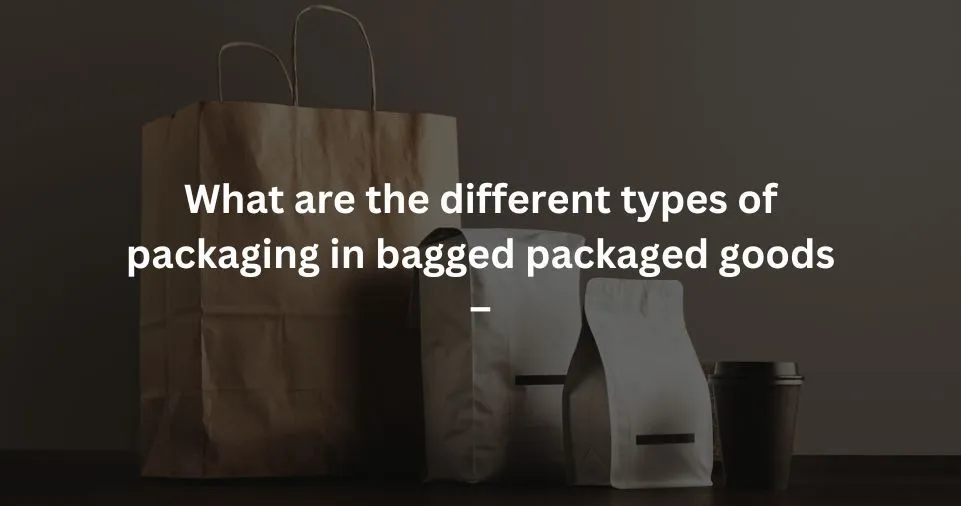Bagged Packaged Goods – Advantages, Types, and Benefits (Updated)
The demand for packaged goods in bags is rising with the rapid global expansion of the retail industry today. The secret to the retail industry’s rapid growth is its attention to customer satisfaction, reviews, and experiences. To them, nothing is more important than a customer, and as a result, they are constantly improving their products. However, packaging is another crucial factor that they should never overlook. Therefore, to please a consumer, the items and the packaging are crucial. Depending on the product, there are many different types of bagged packaged goods: can packaging, box packaging, tray packaging, paperboard boxes, paper bags, polythene bags, cloth bags, etc.
What Is The Difference Between Bag And Package?
These days, consumers are in great need of secure, comfy, and bagged packaged goods. Only customer satisfaction and trust can explain why the retail industry is growing so quickly. However, even though we often use the term “bags and packages,” maybe we have never attempted to define it correctly. If I were to ask you this question, what would your response be? Maybe a lot of you may respond that both are the same since we use them both to transport our goods, leading many to claim that we also use them to safeguard those goods. Yeah! Both responses are accurate. However, there are certain distinctions between bags and parcels.
- Packages are packed in bags, which resemble open containers.
- Bags are soft compared to firm packages.
- Packages are sealed by heat sealing, ultrasonic sealing, jaw design, etc. using a chain of bags.
- Less risky than luggage package.
- People require a bag to transport packages easily from one location to another since they are uncomfortable to hold in hand.
- Although bags and packages are equally affordable, packages are more so. Packages thus cost substantially less than luggage.
- Packages are less resilient than bags. Bags may be used for any kind of long-term cargo.
- Cardboard boxes may also be used as decorations by people. They may build picture frames, butterflies, dream catchers, and other decorative items by cutting and making paper or cardboard packaging to adorn their adorable home.
- Additionally, bags may be washed, but parcels cannot.
Features bags and packages –
Bag-
Definition- It is a container where we can set every type of product properly.
Features of Bags-
- Nobody has to be told how important a bag is since it is simple to carry. Every time we visit a store, whether it be a grocery store, clothing store, pharmacy, or cosmetics store, we attempt to maintain our belongings in a bag since it is so much more convenient.
- Flexible – We can fit a wide variety of items in a bag, including milk cans, water bottles, packets of rice and biscuits, and occasionally even our purses.
- Bags are also appealing in this regard. We can find a wide variety of patterned bags, lovely shoulder bags, and other handbags that are very appealing and fashionable to carry on the market.
- Reusable and washable – This is another crucial feature. After using the bag to transport one item, we may keep it within our home and reuse it to transport further items. The ability to wash bags made of clothing gives clients a very attractive choice.
- Affordable – Bags are so inexpensive that anybody can purchase them.
Package–
Definition: It’s a bit challenging, to sum up in one line. It is a container where the items are packed, such as a chip or biscuit packet, sugar or date packet, or chip or cookie packet.
Features of Packages-
- Safety – Extra-strong bags are meant to safeguard products while being delivered to customers securely. For instance, plastic bags used to package items in bags are particularly durable and waterproof, ensuring that the contents inside reach the client securely.
- Protection: When it comes to “Bagged Packaged Goods,” protection and safety rank first since a package must navigate several challenges before it can reach its destination. Retailers usually take extra effort to ensure client satisfaction since it greatly affects their company.
- Attractive: Customers are drawn in by attractive packaging. Always create a good first impression with your packaging, for both the business and the goods. Therefore, packaging that is appealing is tremendously beneficial to the company.
- Reusable: After getting the product and the packaging, you may use it as a container to keep other essential items. Additionally, bagged packed items have this advantageous and useful quality.
- Travel-friendly and inexpensive – The prices of the packages are really low. Additionally, it is portable and easy to carry in any sort of bag.
- Packages are quite light in weight since they are constructed of paper, paperboard, cardboard, etc.
What are the different types of packaging in bagged packaged goods –

There are many other forms of packaging, but the basic three for bagged packaged items are: 1. secondary packaging, and third-level packaging. I’ve included a brief description of each category in the following:
Primary Packaging – This kind of packaging, which may be either plastic or paper, is particularly popular for bagged packaged items. It involves using a single packet to pack the product. Opening the packet allows customers to quickly get the required items, and the directions for using the product, the expiration date, the customer service number, etc. may also be printed on the exterior of the packet. For instance, the packets for Horlicks and Cornflakes may have such information.
Secondary Packaging – This is mostly utilized after the initial packing to pack more than one or two items or to safeguard only one item so that it reaches the consumer safely. This kind of packing is constructed of cardboard, plastic crates, and paperboard cartoons. This might be thought of as the second layer of the main packing that guards against harm to the essential items.
Tertiary Packaging – The ideal way to handle and carry an item from one side of a nation to another, or sometimes from one point to another point on the globe, is using tertiary packing, which is a rigid and protective form of packaging. Bulk packing and transportation packaging are other names for tertiary packaging.
Ancillary Packaging- ‘Accessory’ is what the term ancillary denotes, therefore in this packing, there are bundled accessories. For example, any machinery or electrical components like a printer, motherboard, monitor, speaker, microphone, ink, or picture paper.
These are the basic forms of packing; farther down, I’ve covered a few others:
Paperboard Packaging – is a widely popular kind of packaging. Lightweight materials are shielding, light-proof, and pollution-proof. Packaging made of paperboard is often used to package meals, cereals, drinks, milk, cosmetics, etc.
Cardboard Packaging – Paperboards only have one layer, but cardboard is comprised of three layers, making it harder than paperboard. Cardboard is more durable and reusable than paperboard, making it an excellent choice for retail businesses that sell packaged items in bags.
Corrugated Box – Corrugated boxes are often used to put fragile necessities in bagged packaged items. Since corrugated boxes are constructed from the same materials as cardboard, they are durable due to their structure and thickness. People may also use these boxes to plant plants or for decorating.
Plastic Boxes- are more beneficial to consumers and far more durable than the alternatives mentioned. These days, plastic crates are the ideal alternative for reuse because of how durable they are. Plastic boxes work well for moving items from one location to another.
These rigid boxes, which are composed of strong cardboard or paperboard and sometimes have the inside filled with leather, plush clothing, fashionable textiles, vibrantly printed papers, etc., are used for luxury items.
Chipboard Packaging –This is simple to fold and cut, comparable to paperboard and cardboard packing, and the size varies with the product. Chipboard packaging is inexpensive and lightweight, and it is often used in the packaging of commodities that are bagged.
Tray Packaging –Cardboard and paperboard were used to make this. This is used to specify the quantity and variety of the items. This is reusable, secure, and comfy. A different kind of packaging for bagged packaged items is the tray package.
Wrapping products in shrink packaging. Both money and space are limited. One of the nicest things about this kind of packaging is that all that is required is heat and plastic.
Vacuum Packaging-The product is sealed in this form of plastic packaging, which is likewise composed of plastic. Bagged packed commodities, mostly groceries like vegetables, meat, and other foods, are wrapped using vacuum packing.
Packaging for Preservation – Shrink and vacuum-sealed materials are used to create packaging for preservation. Maintaining the goods’ freshness and protection is the sole goal of preservation packaging, which is added to aluminum cans and jars packaging. Bagged packed items have additional benefits from preservation packing.
Shock Mount Packaging- Because electronic components are costly and delicate, they are often packed in shock mount packaging in bagged packaged items. This packaging protects electronic components from shock, moisture, and dust. Because it is constructed of a shock absorber, it protects the product from unwelcome shock.
Clamshell Packaging-This is likewise comparable to a box in that it contains two parts that are essentially constructed of thermoform, plastic, and paperboard and attached similarly to a box. In this kind of packaging, the product touches the package directly. For instance, clamshell packaging for burgers, screws, strawberries, etc. “Hinged Packaging” is another name for this clamshell container.
Bottles and Jars-Only liquid-sealed items are kept in bottles or jars. Liquids stored in jars or bottles are secure and bacteriophage-free. They are constructed of glass, high-density plastic, and sometimes low-density plastic.
Poly bags are widely used, reusable, and long-lasting. These are soft yet waterproof. It may be used to transport a wide variety of goods, including vegetable jars, creams, and more.
Foil Sealed Bags-These bags are colorful, flexible, and light in weight. Fast food is often kept in these bags, which are foil-sealed to maintain the heat of the food within. They are not poisonous.
Thermoform Packaging- In thermoform packing, heat, pressure, and vacuum are used to mold thermoform plastic into the desired shape. Thermoplastic sheets, ABC, CAB, EVA, expanded PVC, and other polymers are some examples of thermoform packaging materials.
Crates and Pallets – Pallets and crates are more robust and practical. Crates are ideal for protecting and carrying the required materials. These are constructed from high-density plastic and wood. Many items may be transported simultaneously on pallets and containers without worrying about damage.
I merely attempted to discuss and briefly explain a few of the typical packaging types used in bagged packaged products.
Some common materials used for packaging products are mentioned in the following –
- Plastic
- Glass
- Aluminum
- Paper
- Cardboard
- Cotton
- Steel
- Clay
- Wood
Advantages of Bagged Packaged Goods

- The benefits of bagged packed items are their ease of use and reliability as a packing solution.
- Given their low cost, the packed items in bags also take care to safeguard their contents.
- Another advantage of these packing solutions is that after clients get them, they may utilize them to store necessities, create crafts, grow trees, etc.
- The ability to wash cloth bags makes them a useful characteristic of packaged items that come in bags.
- Purchasing packed things in bags also saves time and is convenient.
- Packaging is very difficult since it is meant to safeguard the essential item. Transportable commodities come in bags that are wrapped.
Some retail businesses are working to enhance packaging because it adds value to the goods being bought and makes a favorable first impression on customers. Because of this, the demand for packaged items in bags is rising globally every day.
Conclusion
Navigating the world of bagged packaged goods might seem overwhelming, but it doesn’t have to be. From understanding their distinct advantages to exploring the multitude of types and benefits, we’ve provided a comprehensive guide to shed light on this important aspect of everyday life. Convenience, freshness, safety, and a wide variety make bagged packaged goods indispensable to our busy routines. In an ever-evolving market, staying informed about these consumer goods can help you make better, more informed choices. So, keep exploring, keep learning, and make the most out of your shopping experience.
FAQs
What are Bagged Packaged Goods?
Bagged packaged goods refer to products that are packaged in bags for the purpose of preservation, convenience, and ease of distribution. They span across various categories, including food, personal care items, and household products.
What are the Advantages of Bagged Packaged Goods?
The advantages include extended product shelf life due to proper preservation, the convenience of use, easy storage, and safer handling. They also allow for portion control and make the transportation of goods more efficient.
What Types of Bagged Packaged Goods are there?
The types of bagged packaged goods vary widely, ranging from food items like snacks, cereals, and frozen goods to personal care items like soaps, shampoos, and cleaning agents.
How do Bagged Packaged Goods Benefit Consumers?
Bagged packaged goods offer consumers the convenience of use and storage, safety in handling, and a wide array of choices. They also help in maintaining product freshness and quality.
Are Bagged Packaged Goods Sustainable?
While plastic bags raise environmental concerns, many manufacturers are now turning towards sustainable alternatives like biodegradable packaging or recyclable materials.






